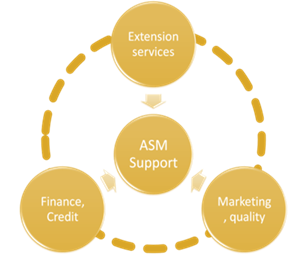The Golden ASM Support Triangle

The AMDC-championed support triangle for ASM, as shown above, highlights some key ASM challenges within the scope of the AMV’s need to address them. These challenges include lack of institutional, technical, financial and regulatory support.
Through the support triangle, the ASM sector can be transformed into an engine for sustainable development, particularly in rural areas, if the aforementioned challenges are adequately addressed through a series of well-targeted interventions. The interventions should recognise the need for [ASM] policy to be embedded into broad rural development strategies, taking into account the poverty cycle that limits the development of the ASM sector (CMV Guidebook).
The three pillars of the support triangle are as follows:
Finance and credit:
ASM sector-specific loans, banks/funds and capital equipment leasing schemes for registered ASM cooperatives and associations. This could involve LSM in supporting the creation and/or strengthening of ASM associations and cooperatives, to promote labour laws and best practices and strategic business linkages between business support providers, technology supply agencies and ASM workers/miners. Financial support for ASM also offers the potential to unlock access to ASM-targeted and ASM-complementary (e.g. agriculture) financial products.
Marketing and quality:
Access to gaurantor financial services, will foster, where regulatory frameworks allow, direct ASM miner engagement with official marketing channels rather than through third parties in payments. Encourage ASM associations and cooperatives’ diversification within the ASM linkages value chain, e.g. cutting and polishing labs/sites; official marketplaces for gemstones, semi-precious and other development minerals, to alleviate problems caused by dealing through intermediaries and third parties. Official marketplaces also help address, where revenue collection systems are robust, ASM sector taxation and help to raise ASM incomes beyond subsistence levels whilst driving the ability of individual artisanal miners to coalesce into cooperatives that will come to upscale operations to small-scale mining metrics. This invariably aids domestic resource mobilisation efforts from the ASM sub-sector.
Innovative and nuanced access methods to marketing and quality guarantee modalities such as participation within ‘fairmined’ practices, can introduce easier if not more rigorous tracking and certification of ASM mined minerals. Taking cognizance of the link between seasonal ASM miners who are subsistence farmers - innovations linked to agricultural food chain supply of ‘fairtrade’ produce, may similarly be adapted to the ASM minerals supply chain in adopting, adapting, maintaining and improving where possible, the already existing standards such as ‘fairmined’.
The fairmined standard for gold and associated precious metals to support sustainable development of artisanal and small-scale mining communities includes requirements for ASM organizations to perform responsible mining: formal and legal mining operations, environmental protection, labor conditions, traceability of certified ‘fairmined’ minerals, and socio-economic development through the ‘fairmined’ premium. It also outlines market models and requirements for market actors - fairmined suppliers.
Extension services:
A phased approach to integrated service delivery and capacity-building is part of the extension services referred to here. Deploying geologist and geosurvey services in ASM areas whilst seamlessly coordinating engagement of environmental and health work services to address negative impacts in the same area. Geological mapping of ASM spaces, with active involvement and participation of ASM miners, as part of formalisation efforts, may incentivise participation of more financial sector support towards ASM. Widening economic options will then be harnessed by involving all other ASM stakeholders in a manner that may see a burgeoning of small-scale mining operations from artisanal miners through mentoring programmes led by established small scale and large scale mining concerns (SSM-LSM). The approach offers promise for added sustainable ASM-LSM relations and embedded capacity building for ASM workers.
The finance and credit leg of the support triangle also draws out the alternative livelihood option for ASM support, as common ground between ASM miners that practice ASM as a seasonal, cyclical activity in-between agricultural seasons and those that do so out of the poverty-led lack of livelihood options due to failed agriculture or agricultural seasons. Financial services based crop payments by local, regional or large multinational commodity buyers can enhance payment ecosystems that can subsequently be leveraged as a distribution channel for the provision of targeted credit, savings, and micro insurance products to farmers-turned ASM miners and vice-versa.
Financial and credit services support within ASM-dependent communities – is likely to expand livelihood options beyond ASM for those areas in which agriculture may be efficiently practiced in-lieu of ASM when supported financially.
It should be noted that the ASM support triangle as championed by the implementation of the AMV through the AMDC is a demonstration of the way in which customization of support for ASM, will always take cognizance of local dynamics. An instance of this would be the formalisation of ASM through country specific quick-win entry points for the AMV’s domestication as part of Country Mining Vision (CMV) interventions.
As highlighted in the CMV guidebook, not every country requires a CMV and some country contexts are more suitable to other mechanisms for domesticating the AMV, even within the realm of the ASM Support Triangle. The flexibility of the CMV intervention process is ideal in ensuring that ASM Support Triangle interventions will always take cognizance of the prevailing policy space and dynamics on the ground, which may be grounded in overarching national development plans and related sectoral policies that go beyond the mining sector to ensure inclusive sustainable development.

